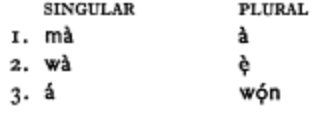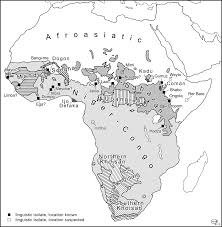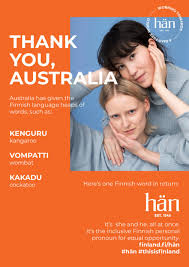As a new resident of Finland and keen learner of Finnish, I was delighted when a Finnish personal pronoun appeared on ads all across Europe. Plastered on tube tunnel walls and advertising boards in London, Paris, Berlin, Madrid and Stockholm and Sydney, witty posters thanked European languages for their lexical gifts to the Finnish language but also announced Finland’s gift to the world: hän.
A little word punching far above its weight according to the Finland Promotion Board and Finnish embassies across the world: “Equality forms a core value for Finland and its people, and the best symbol of Finnish equality is a personal pronoun from the Finnish language: hän. The third-person singular pronoun hän is neutral in terms of gender and social status, so it represents equal opportunity. It is “she” and “he,” all at once, and it has always existed in the Finnish language.”
Occasionally, commentators on social media pointed out that there are, of course, other languages that don’t distinguish between natural genders in their pronouns. But it has escaped attention that the vast majority of African languages does not make a difference between he and she, his and hers. So, really sorry to say it, but move over Finnish, here come the Niger-Congo languages!
This group of languages comprises thousands of languages and covers a huge area of the African continent. Which languages belong to this, the world’s largest, family beyond its inner core, is a matter of debate. But one thing unites them: the absence of natural gender in their rich and varied gender systems. The number of genders and of the distinctions on which they are based differs widely. Many languages have genders for nouns that denote referents with particular shapes, as does the Atlantic language Gujaher, on whose gender system I blogged earlier here and here. Most languages have particular genders for very big and very small items, and all of them have a class that collects most human beings. But within humans, no grammatical distinction between male and female referents that could give rise to masculine and feminine genders is made. In the third person, pronouns or agreement markers either encode the gender of the noun they refer to or simply the person and number – 1st, 2nd. 3rd, singular, plural, collective… Here are the six subject pronouns of Yoruba from Ayọ Bamgbose’s (2000 )grammar, with no sex distinction in sight:

Cross-linguistically, the absence of biological gender is rather unusual, as you can read in Greville Corbett’s gender overview in the World Atlas of Language Structures. But do gender-neutral languages advance gender equality, as claimed by the Finland Publicity Board? Some might say yes, including the Swedish campaigners who introduced the gender-neutral pronoun hen into this language, with otherwise marks biological gender in pronouns. Or the feminist scholar Oyèrónkẹ́ Oyèwùmí , author of The Invention of Women: Making an African Sense of Western Gender Discourses. She argues, based on evidence that includes linguistic organisation and the absence of the marking of natural gender going hand in hand with marking of seniority in the language system (on which I have written in this post) that male and female genders were no meaningful social categories in precolonial Africa.
Language can both be a symptom, a fossilised indicator, of deeply rooted social structures (since language encodes those categories best that speakers care(d) for most), and a driver for social change. But languages with and without natural gender distinctions co-exist in the same geographical spaces ad are spoken by multilingual populations with very diverse local cultures. This holds for Swedish and Finnish, and for Niger-Congo and Afro-Asiatic languages (many of which do have sex-based pronouns), among others.
Regarding their role in social change, then, languages can at best serve as a blank slate which can be co-opted in imagining it, as done by the Finland Promotion Board: “Finland wants to encourage international dialogue on equality by introducing a Finnish word to the world: hän. In this campaign, hän is a tool for telling the Finnish story about equality as a source of strength for society.” Billions of speakers of African Niger-Congo languages could lend their words to this endeavour. Because their pronoun is…. 3rd person singular.
References
Bamgbose, Ayọ. 2000. A grammar of Yoruba. Cambridge: Cambridge University Press
Corbett, Greville. 2013. Sex-based and non-sex-based gender systems. In: Dryer, Matthew. S and Haspelmath, Martin (eds.): The World atlas of language structures. Leipzig: Max Planck Institute for Evolutionary Anthropology. http://wals.info
Oyèrónkẹ́, Oyèwùmí. 1997. The invention of women: Making an African sense of Western gender discourses. Minneapolis: University of Minnesota Press






A lack of gendered pronouns may well help with having an egalitarian society, but it doesn’t necessarily create one. Gendered pronouns are absent throughout East Asia, where most cultures are traditionally intensely patriarchal.
LikeLiked by 1 person